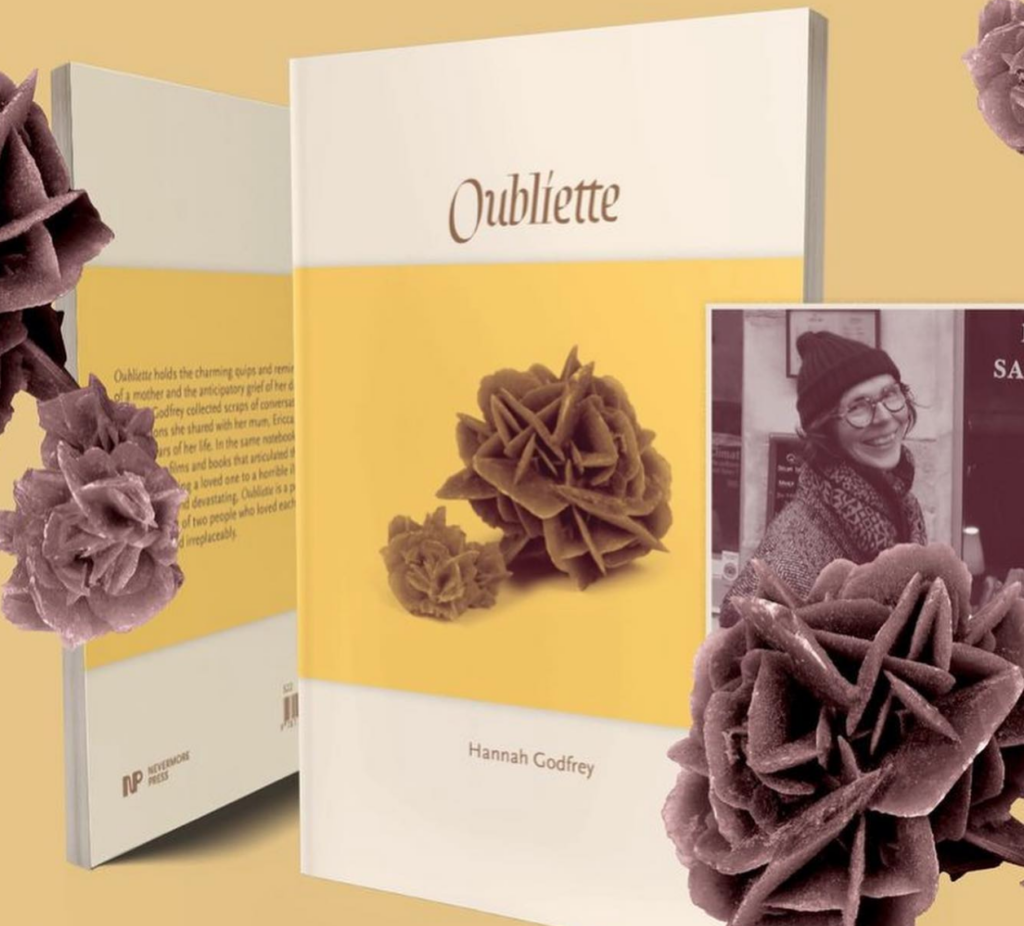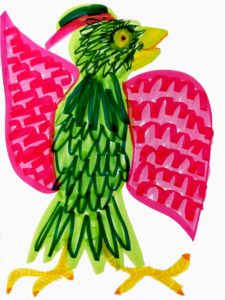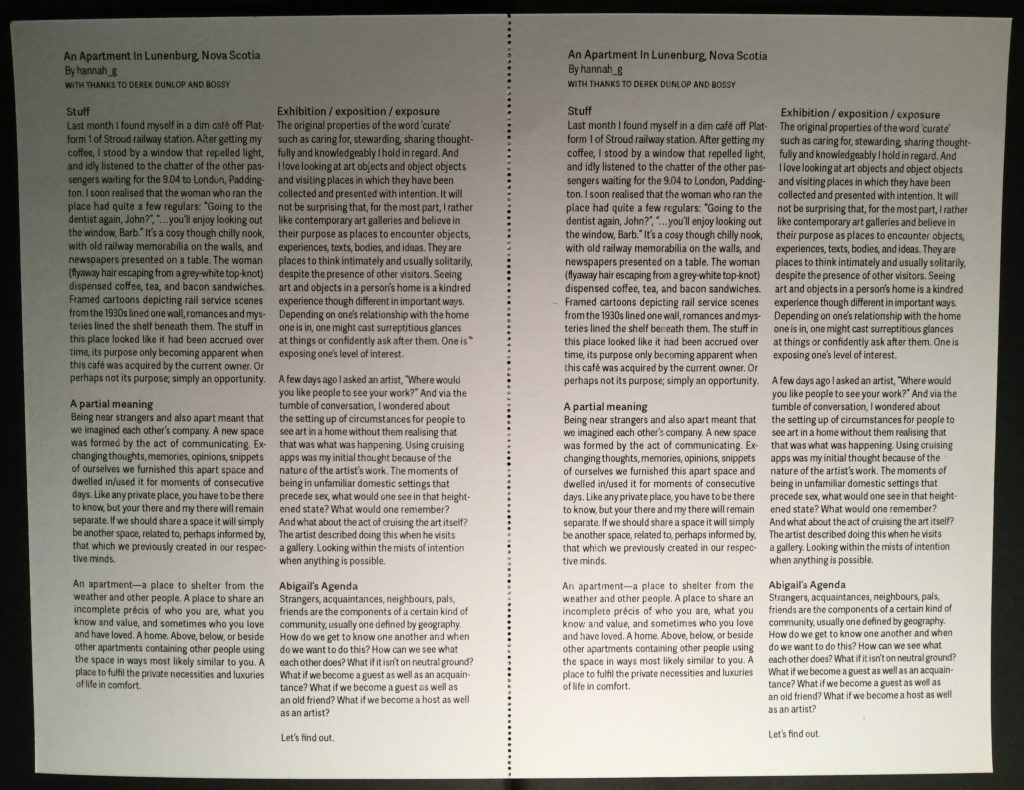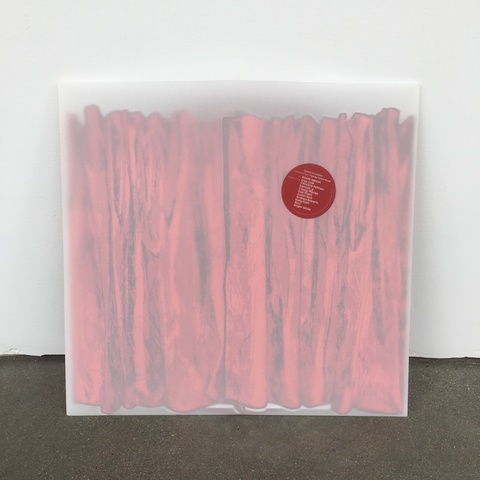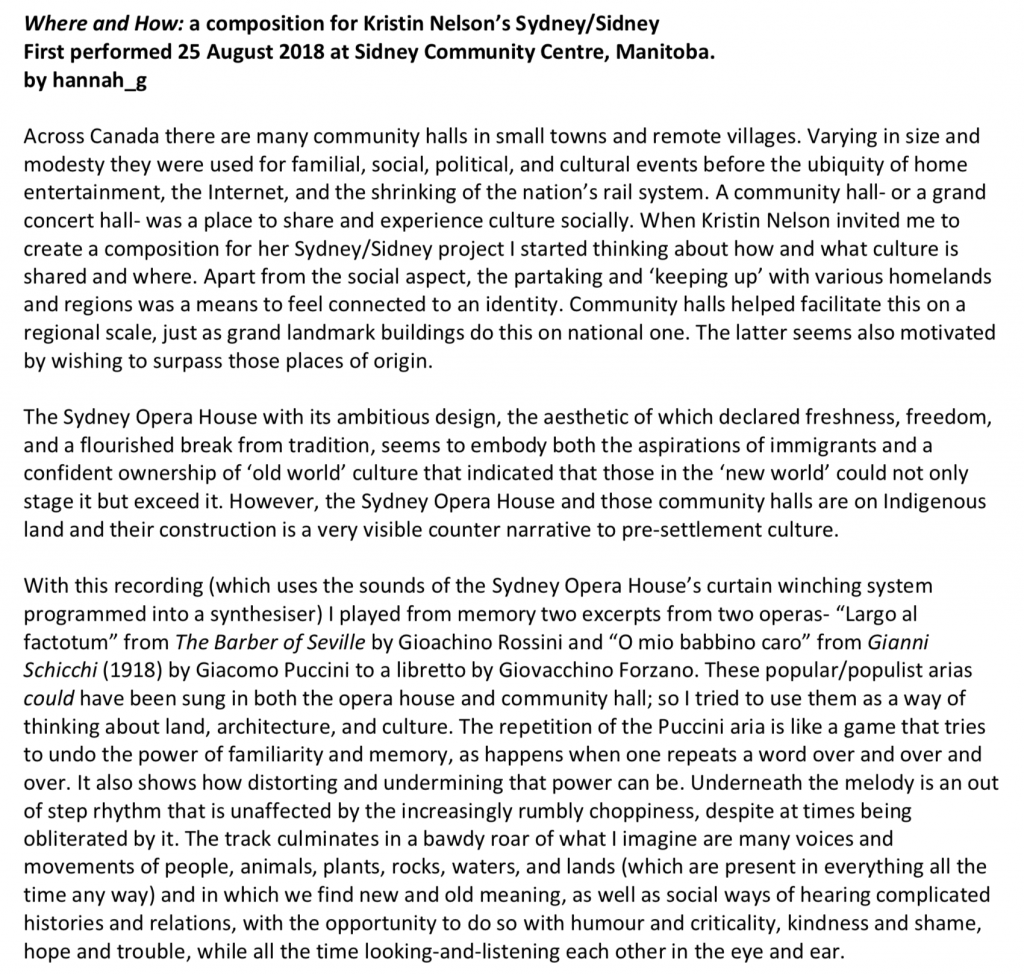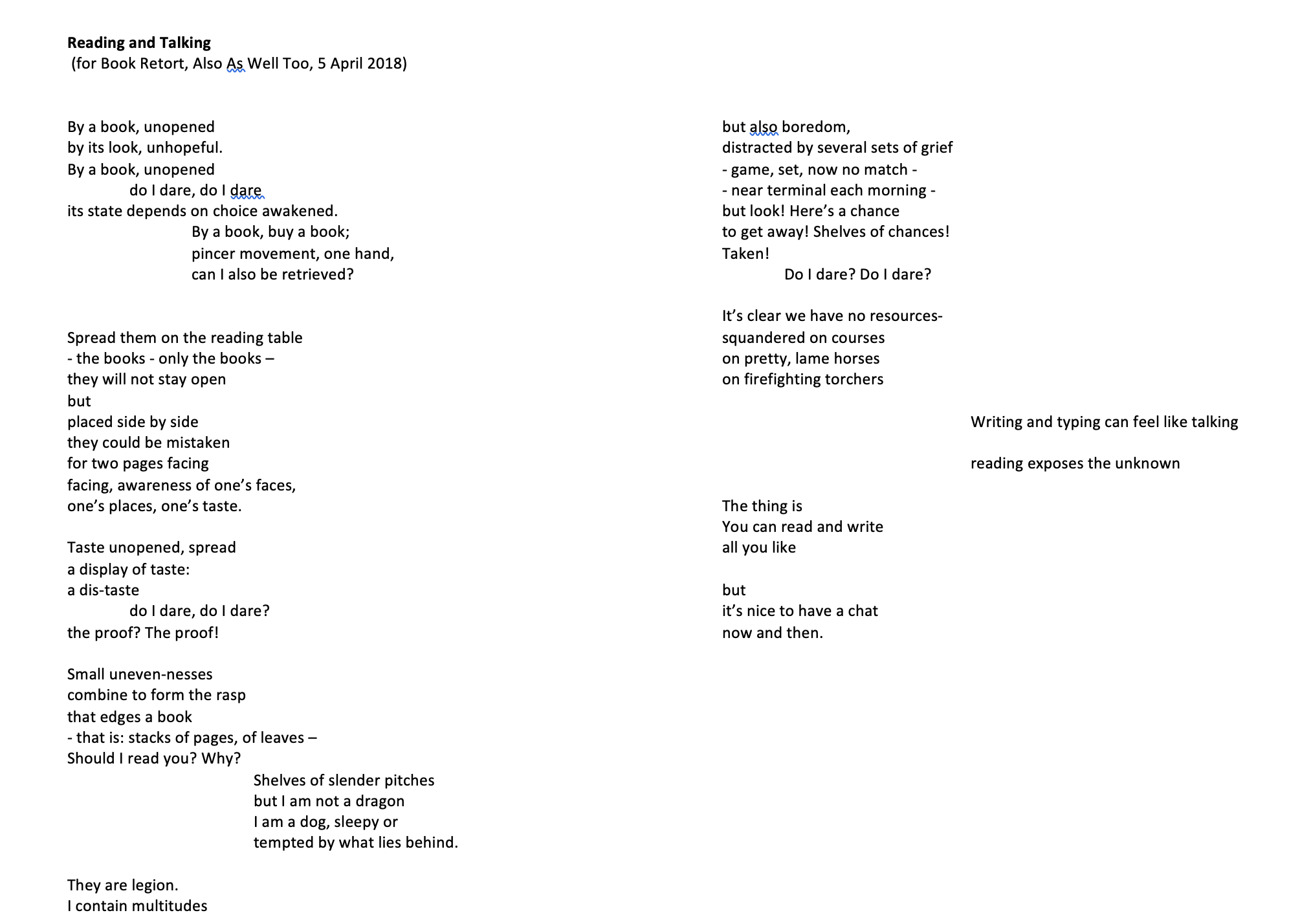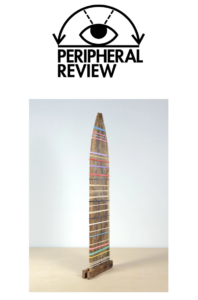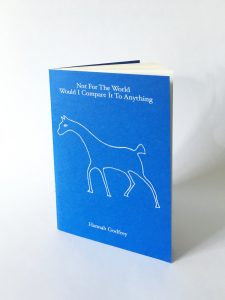One writer and one visual artist or photographer are paid to participate in the Research Series by creatively responding to the work of the in-residence artists. The point of the program is to allow for exchange across discipline and to create opportunities to broaden the exploration of the artists in residence by offering multiple in-depth perspectives. Writers and visual artists are invited to participate at various times throughout the year.
In the Autumn of 2017, I was paired with Davis Plett, Alexandra Winters, Warren McLelland, Kayla Jeanson, Brianna Ferguson, and Rachelle Bourget.
Here’s a link to the online essay. Below, the whole text is pasted.
https://younglungs.ca/2018/11/15/seeing-and-knowing/
seeing and knowing
Produced as part of Research Series September-November 2017
I was looking at some reproductions of Torey Thornton’s paintings the other day. Colourful, witty, the paintings contain forms which correlate to things in the world one may be familiar with – tiger stripes, fruit, a herd, furniture. Getting into their specifics, however, places one in the realm of conjecture. Is the tiger dead or alive or someone in a tiger suit? Is that blob a table or a rug? “His work oscillates between legibility and abstraction,” as the Almine Rech Gallery puts it. This oscillation – which occurs across many disciplines – provides the means for recognition, alienation, self discovery, enjoyment, connection, boredom, distraction, contemplation … that is, it provides a means of exchange.
.
Alexandra Winters & Warren McLelland
*
Speed, strength, stamina, and repetition are common elements of sport and dance: Winters’ choreography on McLelland and herself sought the crossover between the two and thereby perhaps the epiphany of a common intention.
The cheers from a huge crowd was the work’s soundtrack and accompanied McLelland’s warm up jog which stopped abruptly at one of the studio’s pillars (amongst four of which the piece was placed to infer a sporting frame such as a baseball diamond, the corner of a soccer field, or a ring). Here his body opened into the star shape that often accompanies a sporting moment, such as when a soccer player strikes the ball for a long punt or baseball fielder is in the air straining to make a catch. For the duration of the first half of the piece, McLelland referenced a cluster of sporting gestures from soccer and football players, baseball shortstop and batter, ice hockey goalie, and referees, which the choreography stylised, decontexualising them so that aggression, efficiency, and the need to win made way for a physicality that elicited other references that included voguing and ballet as well as moments that fell entirely out of specific techniques. Winters, dressed in the black t-shirt and shorts most readily associated with referees, signified the second half. Offsetting the ref reference, she engaged McLelland combatively, emulating the intimate, non-sexual physicality of engaging an opponent that is premised on the ability and conditioning of bodies and the technique that has been worked into them over many years. Winters’ body interrupted the assumed masculinity of sport and aggression, emphasising interaction over competition. This allowed for a moment where both performers flowed out of their floor hold and into lying on their backs, fist pumping tiredly in rhythm with the cheering, which accompanied the whole performance. After a few seconds they reengaged and returned to their sparring and teaming.
Both performers maintained a ‘game face’, their expressions telling us that they were concentrating on something outside of themselves that wasn’t necessarily each other or what the audience could actually see. Their movement, which required much strength and created many forms that were almost micro tableaux, ranged around the performance area, filling it. The absence of prescribed emotion heightened the impression that they had stakes in what their physicality was going to achieve in the moment, which, I suspect, led to the audience having an investment in the piece that was not based only in emotional receptivity, but in an abstraction of sport’s movements, techniques, and consequences, and of players’ and spectators’ bodies and relationships.
.
Kayla Jeanson, Brianna Ferguson, & Alexandra Winters
In Labyrinthinitis, Jeanson explores the effects of YouTube’s stabilisation tool on the bodies of the dancers she videoed. Learning the movements which would prompt the tool to act most noticeably, Jeanson created choreography that would elicit the greatest intervention by the tool. There is a resemblance between the successful gestures – swinging, swaying, eyes moving slowly from side to side, jumping, hands twisting and pirouetting – and it is tempting to think of them as a little primate-like or as the cause of the simultaneous movement of the background and floor line, but the piece cautions against such interpretation or categorisation, implying that this itself will change the way the work is seen.
Jeanson’s processed videos show bodies that we are watching via something else’s observation. The sensation of being behind some one’s or thing’s eyes is like playing a part in the movie Being John Malkovich but in this circumstance the observer, the Artificial Intelligence behind the stabilisation effect, changes in a real way that which is observed. Although popular consciousness is familiar with the principle that particles change according to whether they are or are not watched (the Zeno effect) and is parallel to research in the social sciences that posits perception can change how the perceived is interacted with, it is still shocking to see what those changes actually look like and how they effect us.
The jerks, the unnatural flow of the bodies whose natural timing has been disturbed, the odd panning in the shots, the slight zooms, and the shudders of the background, all make for an uncanny experience. These once freely moving human bodies, now processed, are assigned an A.I. interpretation of their movement and the bodies are corrected accordingly. Animation techniques are brought to mind, but this stabilisation effect is animating something that is already animated, that is living, in order to create what it calculates is conventional or ‘normal’. One could think of this as a kind of metaphor for the issues of body conventions much of the dance world struggles with. One is also reminded that defining and enforcing ‘the normal’ is a characteristic of tyranny. Thus digitising and editing bodies also raises questions of who or what does the defining and enforcing and what are the implications when we can no longer discern that an image or video is ‘off’ and therefore manipulated and hence what is real, what is not, what is true, what is a false, who is in control.
.
Davis Plett & Rachelle Bourget
Rituals are a means of encoding specific sequences of actions that are designed to exert a form of power. They often mark or are attempts at transformation. Bourget performed an intense interiority, her movement communicating a concentration and purpose usually reserved for ceremonies. She slowly crossed the space holding a cardboard box in front of her face and then after setting it down she removed a plastic bag from which in turn she took the dividers common to wine boxes then proceeded to slot them together to make three shapes we knew must be pre-determined given her manner of construction. This was part one and was, among several other things, a witty flirtation with the tedium that accompanies rituals with which we are overly familiar or have no stakes in. But the central preoccupation of the piece seemed more about deconstructing the power structures within bodies that have acquired particular vocabularies from specific training. Such training includes making itself clearly evident in the actions performed by those bodies, thus the bodies are allied to a set of rules created by schools of movement and thought. Plett choreographed the performance to objectify Bourget’s training which led to the disassembling of the meaning of everything she interacted with. The wine bottle dividers stopped being wine bottle dividers and became abstract sculptures; they were separated from their intended purpose (which named them) via a ritual. We still see the divider, and the training, but accept and believe the transformations and the opportunity to become immersed in the spaces that form when meaning expands.
In the second part of the performance, Plett in plain sight, puppeteers a crumpled, thin plastic sheet from the ceiling, fidgeting it’s four sides to make it become a ghostly jellyfish that descends onto an almost full Fanta bottle placed on top of a red sheet of Mylar over an overhead projector. Aside from the phantom/Fanta pun, the performance seemed a reinterpretation of Bourget’s ritual: whereas the first observed transformation was that of the cardboard dividers, the plastic bags in which they had been packed and then carefully folded away were also changed by her performance and were then able to leave the confines of their prescribed purpose to potentially flap away into another. Thus we see Plett’s training, as well as the ripple between accepting one story for another.
Playing Ball – Research series story
The waves tumbled over the rocks and onto the beach, muscular and doubtless. A friend of Kenneth’s, a pitcher, had told him how he’d go to the beach when he had the blues and imagine the sea was a cheering crowd willing him to do well. When this pitcher won a chunk of cash on a scratch card, he blew the lot on a couple of crates of baseballs. He took them to the beach and spent a day pitching them into the sea: an offering to the waters.
Kenneth had come into a little money himself and decided to do what his friend had done. He brought his two crates to the beach and as the sun was beginning to set, he pushed his hand into its well worn mitt and limbered up, swinging his arms, rotating his shoulders, twisting his torso, getting the joints lubricated and muscles warm. He’d spent more of his life playing baseball than not and his body was shaped by its rhythms and repetitions. A centre fielder and star batter, he had moulded his body to swing, sprint, catch, and throw with the greatest power and efficiency. The form suited him but he worried his mind had become conditioned into a certain shape too and that he wasn’t thinking and moving in the world with full autonomy.
He threw the first ball far out into the waves. The sound of the sea heightened his awareness of his own movement. Kenneth felt his concentration transform his physicality from utilitarian to ritualistic, a set of repeated gestures that allowed him to experience everything as everything. He was used to concentrating on his body but now it was as if the sea was washing a film away. He experienced himself with a fresh intensity, feeling the ball, his mitt, the breeze, the rising moon and his body as profoundly related to one another.
The moon was at its zenith when he abruptly stopped pitching. He realised he wasn’t exercising oneness at all, he was simply polluting the sea. “Shit,” he groaned, his arms dropping to his sides. He stared at the waves rolling on and on, their cheering sounding more like anger. Even his staring felt like it changed the sea – was that polluting it too? The rhythm of the water now seemed off, too jerky but also too smooth. He switched between staring hard and pretending not to look, trying to discern just what effect, if any, he was having. It made him nauseous and he tightly closed his eyes. In his head a bunch of ball players appeared, each looped on a snippet of their game movement. When he contemplated them as a group their movement was regular, recognisable but when he focused on one, her gesture wobbled and his own perspective rippled in response making him very uneasy. A disturbance in the shallows snapped his eyes open and his mitted hand shot into the air in reflex to the blob flying towards him at speed. He made the catch- a wet baseball. He scanned the waters expecting to see a swimmer but there was none. Taking a few steps forward to scrutinise the surf more closely he saw a dull glowing – a group of jellyfish bobbing like phantoms. Another ball broke the surface above them and Kenneth made the catch. Quickly he pulled off his mitt, grabbed his bat, and ground his back foot into the sand. He waited, bat raised, eyes on the shallows. Another ball hurtled towards him – he made contact – a fly ball. Another came, he made contact again, and the crack told him it was a homer. He watched it land far out into the moonlit waters. ‘What am I doing?’ he thought, throwing down his bat and shoving his mitt back on. He waited. Eventually a ball came, he caught it, and threw it into a crate. Another ball came and he passed it onto the crate again and a pattern began.
Dawn broke, misty and grey. Kenneth’s two crates were full and piled up next to them were enough balls to fill another two. It had been a while since the last ball had appeared but he was still alert and limber for a good while before accepting it was done. He straightened up and took off his mitt, an ancient piece of battered, memoried leather. He walked with it to the water’s edge and drew back his arm in preparation for a final, awesome throw. The jellyfish, with their strange staccatic ballooning, had gone. If he threw his mitt it would not be returned and even if it was it would be changed and no longer be a part of his body as it was now. He turned and threw it onto the top of the pile of balls. Somethings are simply yours.
